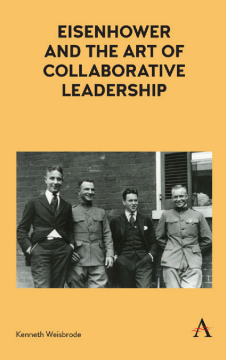
Additional Information
Book Details
Abstract
"Eisenhower and the Art of Collaborative Leadership" examines the theory and practice of collaboration, and collaborative leadership, in the life and career of Dwight Eisenhower. It relates his collaborative style to his ideas about friendship, his Kansas upbringing and his family, his military training and career, and his particular practice of presidential leadership, which operated through teams and a deliberate, sophisticated system of bureaucratic consensus-building. "Eisenhower and the Art of Collaborative Leadership" elaborates an alternative interpretation of such leadership, describing Eisenhower not merely as a “hidden-hand” president, but also as a visible one at the head of a well-managed team. It is a concise portrait of one of America’s most important and talented leaders, and a case study in sound leadership.
“Kenneth Weisbrode has written an elegant assessment of a leadership style not widely practiced, but one that speaks to our times. It brims with insight.”
—Susan Eisenhower, author of Mrs. Ike
Leaders are persons generally expected to excel at inspiration, persuasion and management. Few leaders, however, excel at all three equally. ‘Eisenhower and the Art of Collaborative Leadership’ examines one leader – Dwight Eisenhower – who was particularly adept at management. Rising through the ranks of the interwar US Army, Eisenhower became a valued staff officer who went on to lead the Allies to victory in Europe in the Second World War. From there, after becoming NATO’s first supreme allied commander, Europe, he served two terms as president of the United States.
Eisenhower’s leadership skills were sophisticated in their outward simplicity. He led not by force of personality alone but also by careful and deliberate mastery of team-building; by empathy for friends as well as foes; and by an uncommon respect for, and sometimes even deference to, the positions and interests of the members of his team. It was also remarkable that Eisenhower did all that less by the informal manipulation of relationships than through the formal structures of command and of government, which he crafted to produce the decisions and actions that he sought in the national interest.
‘Eisenhower and the Art of Collaborative Leadership’ examines Eisenhower’s unique art of collaborative leadership by tracing its roots in his family and education, and then by measuring it against the standards of some classic texts by scholars of leadership and the presidency. It is a concise portrait of one of America’s most important and talented leaders, and a case study in sound leadership.
Kenneth Weisbrode is assistant professor of history at Bilkent University, Turkey. The author of The Year of Indecision, 1946 (2016) and Churchill and the King (2013), Weisbrode received his PhD from Harvard University.
Table of Contents
| Section Title | Page | Action | Price |
|---|---|---|---|
| Cover | Cover 1 | ||
| Front Matter | i | ||
| Half-title | i | ||
| Title page | iii | ||
| Copyright information | iv | ||
| Dedication | v | ||
| Table of contents | vii | ||
| Preface | ix | ||
| Chapter 1-8 | 1 | ||
| Chapter 1 Introduction | 1 | ||
| Chapter 2 Family | 15 | ||
| Chapter 3 Friends | 25 | ||
| Chapter 4 Educators | 39 | ||
| Chapter 5 Leaders | 49 | ||
| Chapter 6 Soldiers | 63 | ||
| Chapter 7 Statesmen | 79 | ||
| Chapter 8 Conclusion | 91 | ||
| End Matter | 93 | ||
| Selected Bibliography | 93 | ||
| Index | 97 |
